It looks like you're using an Ad Blocker.
Please white-list or disable AboveTopSecret.com in your ad-blocking tool.
Thank you.
Some features of ATS will be disabled while you continue to use an ad-blocker.
share:
As to the twin towers - because they came down in a manner indicating precise timing, and, because of the actual presence of active thermitic material
in the dust, I think it's safe to say that an explosive, rather than a DEW phenomenon, was involved. This is furthur supported by the explosive
nature of the events, and yet, the degree of puverization of almost ALL building material, as the descending debris wave continued (without any
appreciacable loss of or change in momentum) remains a mystery, and one that, perhaps could be explained by the additional use of a DEW weapon, which
if present could only have been directed from an orbital platform given the degree of precision involved, and while that's rather "far out" as an
explanatory proposition, even still it makes more sense than the official story which amounts to what I call "the foot of God hypothesis" in terms
of it's explanatory power relative to the actual phenomenon of destruction itself.
reply to post by NewAgeMan
Pure nonsense.
As to the twin towers - because they came down in a manner indicating precise timing, and, because of the actual presence of active thermitic material in the dust, I think it's safe to say that an explosive, rather than a DEW phenomenon, was involved.
Pure nonsense.
Originally posted by Rubicant13
reply to post by Drunkenparrot
When have you ever heard of a building in the vicinity of a another large building falling down from the impact of a building adjacent to it?
I'm sorry but this doesn't make any sense, are you inferring that there is some law of nature that would make it impossible?
Are you saying that there wasn't sufficient mass or energy involved from the collapse of the north tower for the impacting debris to have compromised building 7's structural integrity and damaged the buildings fire suppression system?
The modern skyscraper is only 100 years old, how many historic examples of structural failure and all the associated variables do expect would we have in a century?
I think that perhaps you are substantially underestimating the magnitude of the energetic potential contained in a 110 story tall building. Remember F=MA, it is the exact same mechanism that gives planetary impacts their tremendous destructive potential.
Here is a better overhead view of the WTC complex post collapse showing the scale and radius of the area affected.

Link to full size 2,992 × 2,242p image
Originally posted by Rubicant13
And WWTC 7 also had that same iron reinforced steel as the Twin Towers. So what you are saying that you believe the force of the towers falling caused another reinforced steel I-beam building to fall down?
When you say "reinforced steel" are you referring to the metallurgical composition of the raw material used to fabricate the building components or are you referring to the structural engineering like truss systems etc.?
Most of the steel used in both towers was A-36 carbon steel, nothing special and at the bottom end of ASTM structural steel grades.
The engineering of WTC 1/2 and 7 were markedly different as well, neither were simply "steel reinforced I-beam" structures.
WTC 1 and 2 used a tube frame construction where the load is distributed between the building shell and the core which is considerably lighter than the solid steel frame construction of buildings like the Empire State building (which is closer to what I believe you are referring to as a "steel reinforced I-beam building").
The design of WTC 7 was unique in that that it was built on pre-existing caisson's that required the bottom floors to implement some clever load redistribution design resulting in a complex system of transfer trusses that allowed for a large open atrium that ultimately contributed to the failure of the building 7 structure.
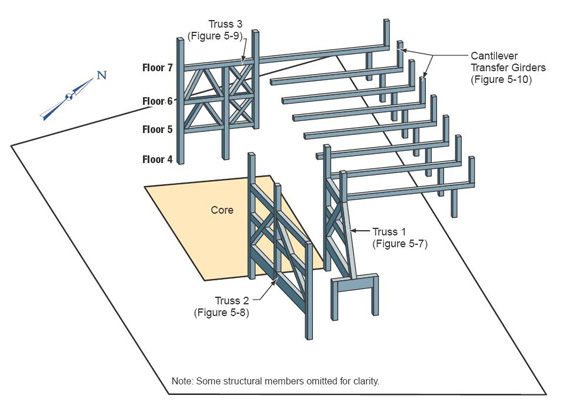
Originally posted by Rubicant13
I can't buy that whatsoever. I have never heard of such a thing happening.
Ever heard the old saying "my mind is made up, don't confuse me with the facts"?
You have brought up quite a few points that I feel have been substantially addressed with sourced, empirical fact.
We are all entitled to our own opinions but not our own facts.
Originally posted by Rubicant13
And WTC 7 wasn't a building that was falling apart, either. It was in pretty solid shape.
WTC 7 got dinged on the south side but what ultimately doomed the structure was the unchecked fire compromising an already damaged structure.
It is thoroughly covered in the 88 page NIST report linked in my previous post...
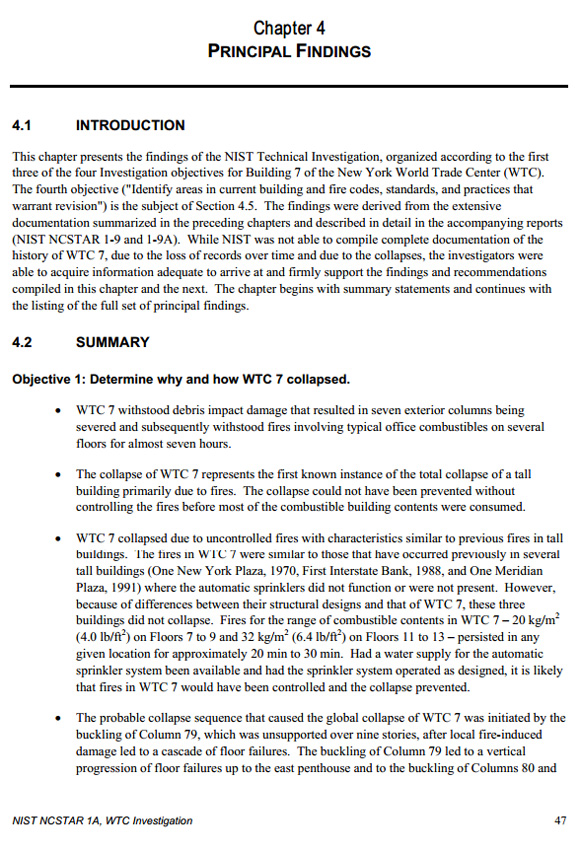
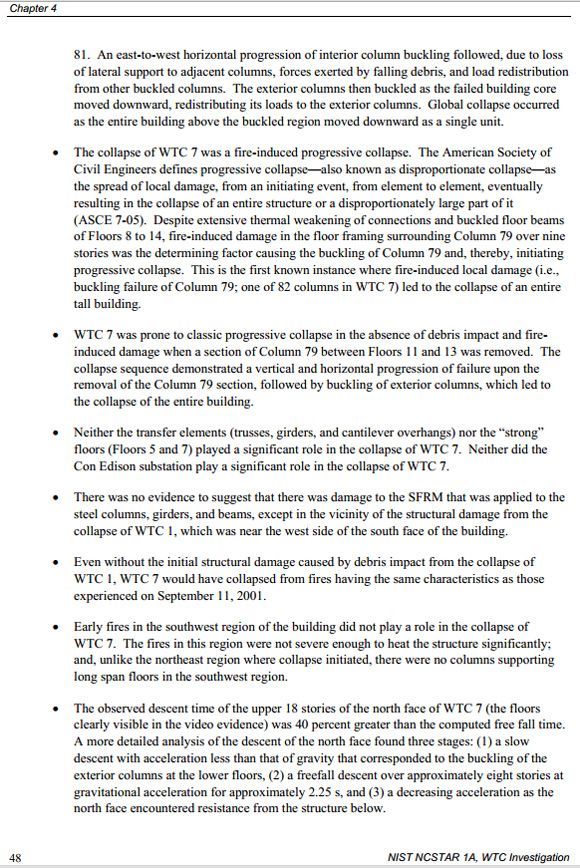

edit on 17-11-2012 by Drunkenparrot because: (no reason given)
So you are saying that tower 1 and tower 2 had a tubed steel A36 structural truss assembly? Every report I have found mentions an iron reinforced
steel I-beam set up for both towers. I also know that A36 is considered the "generic " form of steel in the profession I work. It has low high
temperature heat resistance and has a lower melt temperature than iron reinforced steel - tubed steel has a higher weight pressure tolerance than
supports made.of A36 solid truss steel though, I will say that Your link is to a pictures of a tube assembly set up, but are not citing what source
you got them from. Do you have other links sourcing them to the World Trade Centers?
Originally posted by Rubicant13
So you are saying that tower 1 and tower 2 had a tubed steel A36 structural truss assembly? Every report I have found mentions an iron reinforced steel I-beam set up for both towers. I also know that A36 is considered the "generic " form of steel in the profession I work. It has low high temperature heat resistance and has a lower melt temperature than iron reinforced steel - tubed steel has a higher weight pressure tolerance than supports made.of A36 solid truss steel though, I will say that Your link is to a pictures of a tube assembly set up, but are not citing what source you got them from. Do you have other links sourcing them to the World Trade Centers?
A-36 angle steel chords with round A-441 webbing.
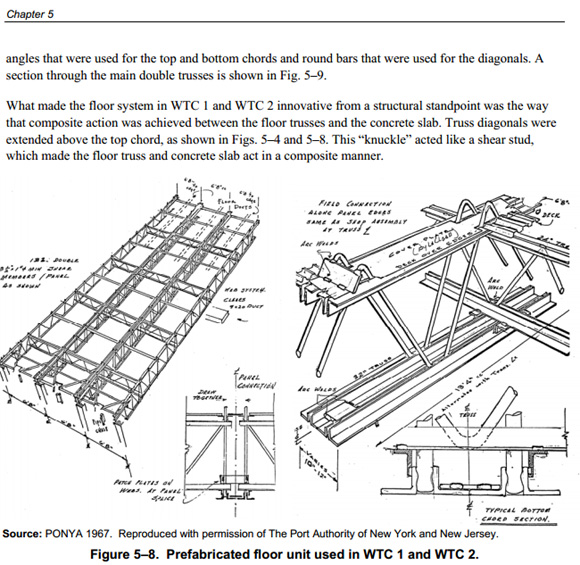
Sorry for not posting the source, both the above diagram and the engineering calc's are from here...
Design and Construction of Structural Systems. Federal Building and Fire Safety Investigation of the World Trade Center
Ok. You mentioned that A36 carbon steel was used in a tube pipe type fashion for the trusses of the World Trade center buildings. A36 carbon steel is
a high grade reinforced version of normal A36 steel (I have worked with both) and Carbon A36 has a melt temperature (depending on the density of
carbon) between 2600 degrees F and 2800 degrees F. I have seen the A36 Carbon steel I have been around melt at 2750 degrees F. No building designer in
their right mind would use regular A36 steel, which is a mild steel, with a lower melt temperature and low tensil strength at lower temperatures; such
as a jet fuel fire for instance. Below is a link describing regular A36 steel:
www.ehow.com...
www.ehow.com...
edit on 17-11-2012 by Rubicant13 because: (no reason
given)
Originally posted by Rubicant13
So you are saying that tower 1 and tower 2 had a tubed steel A36 structural truss assembly? Every report I have found mentions an iron reinforced steel I-beam set up for both towers. I also know that A36 is considered the "generic " form of steel in the profession I work. It has low high temperature heat resistance and has a lower melt temperature than iron reinforced steel - tubed steel has a higher weight pressure tolerance than supports made.of A36 solid truss steel though, I will say that Your link is to a pictures of a tube assembly set up, but are not citing what source you got them from. Do you have other links sourcing them to the World Trade Centers?
I think you're correct.
Originally posted by samkent
reply to post by NewAgeMan
As to the twin towers - because they came down in a manner indicating precise timing, and, because of the actual presence of active thermitic material in the dust, I think it's safe to say that an explosive, rather than a DEW phenomenon, was involved.
Pure nonsense.
Originally posted by NewAgeMan
Explosions?
Originally posted by NewAgeMan
reply to post by maxella1
Here's a couple more dealing with the first hand accounts.
Originally posted by NewAgeMan
Originally posted by maxella1
What would they (rescue workers at Ground Zero) find in the wreckage if bombs were used Dave?
Active thermitic material, and high temperatures, maybe..?
Active Thermitic Material Discovered in Dust from the 9/11 World Trade Center Catastrophe
from www.benthamscience.com...
Also worthy of evaluation
The Journal of 9/11 Studies
Originally posted by Rubicant13
Ok. You mentioned that A36 carbon steel was used in a tube pipe type fashion for the trusses of the World Trade center buildings. A36 carbon steel is a high grade reinforced version of normal A36 steel (I have worked with both) and Carbon A36 has a melt temperature (depending on the density of carbon) between 2600 degrees F and 2800 degrees F. I have seen the A36 Carbon steel I have been around melt at 2750 degrees F. No building designer in their right mind would use regular A36 steel, which is a mild steel, with a lower melt temperature and low tensil strength at lower temperatures; such as a jet fuel fire for instance. Below is a link describing regular A36 steel:
www.ehow.com...edit on 17-11-2012 by Rubicant13 because: (no reason given)
The documents I have posted are the original Laclede Steel Company engineering specifications and architectural details that were used for the construction of the WTC floor truss system.
At the risk of being redundant, the bottom of the page where it says material... what does it say?
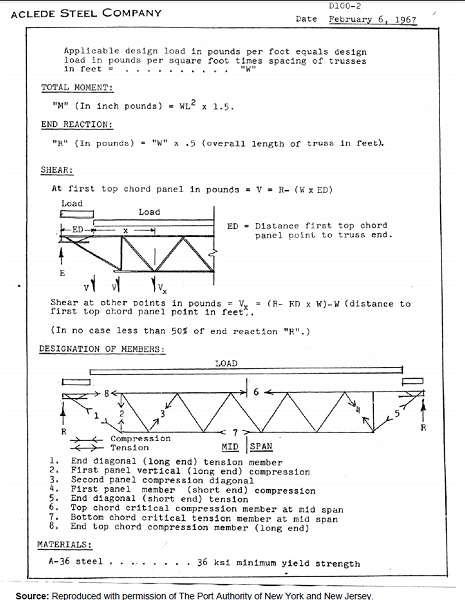
Feel free to share your metallurgical knowledge but A-36 was the material used.
Read section 5-1 on page 129 of the NIST NCSTAR link I posted above, these were stamped by the New York Port Authority and met or exceeded all safety criteria at the time.
Originally posted by NewAgeMan
Originally posted by Rubicant13
So you are saying that tower 1 and tower 2 had a tubed steel A36 structural truss assembly? Every report I have found mentions an iron reinforced steel I-beam set up for both towers. I also know that A36 is considered the "generic " form of steel in the profession I work. It has low high temperature heat resistance and has a lower melt temperature than iron reinforced steel - tubed steel has a higher weight pressure tolerance than supports made.of A36 solid truss steel though, I will say that Your link is to a pictures of a tube assembly set up, but are not citing what source you got them from. Do you have other links sourcing them to the World Trade Centers?
I think you're correct.
A quick heads up.
Rubicant is talking about truss construction and you cant see the trusses, much less whether they are made of angular or round parts in the picture you posted.
What exactly do you believe he is correct about in the photo?
Its all in the details...
edit on 17-11-2012 by Drunkenparrot because: (no reason given)
Originally posted by Drunkenparrot
Originally posted by Rubicant13
Ok. You mentioned that A36 carbon steel was used in a tube pipe type fashion for the trusses of the World Trade center buildings. A36 carbon steel is a high grade reinforced version of normal A36 steel (I have worked with both) and Carbon A36 has a melt temperature (depending on the density of carbon) between 2600 degrees F and 2800 degrees F. I have seen the A36 Carbon steel I have been around melt at 2750 degrees F. No building designer in their right mind would use regular A36 steel, which is a mild steel, with a lower melt temperature and low tensil strength at lower temperatures; such as a jet fuel fire for instance. Below is a link describing regular A36 steel:
www.ehow.com...edit on 17-11-2012 by Rubicant13 because: (no reason given)
The documents I have posted are the original Laclede Steel Company engineering specifications and architectural details that were used for the construction of the WTC floor truss system.
At the risk of being redundant, the bottom of the page where it says material... what does it say?
Feel free to share your metallurgical knowledge but A-36 was the material used.
Read section 5-1 on page 129 of the NIST NCSTAR link I posted above, these were stamped by the New York Port Authority and met or exceeded all safety criteria at the time.
Well. I must say that I cannot argue the point that they used A36 regular grade steel. But, this is used in the trusses. Or building roof supports. Trusses are not used in any other floor of a skyscraper other than the roof, or more in detail, the weight support for the roof. What was the grade of steel chosen as the supports for all the other floors?
edit on 18-11-2012 by Rubicant13 because: (no reason given)
Originally posted by Rubicant13
Well. I must say that I cannot argue the point that they used A36 regular grade steel. But, this is used in the trusses. Or building roof supports. Trusses are not used in any other floor of a skyscraper other than the roof, or more in detail, the weight support for the roof. What was the grade of steel chosen as the supports for all the other floors?edit on 18-11-2012 by Rubicant13 because: (no reason given)
What we have been discussing is the floor support system.
The term "truss" actually has a much broader meaning than the pitched assembly of chords and webbing that carries the weight of a roof.
If you don't mind using Wikipedia for a source...
There are two basic types of truss:
The pitched truss, or common truss, is characterized by its triangular shape. It is most often used for roof construction. Some common trusses are named according to their web configuration. The chord size and web configuration are determined by span, load and spacing.
The parallel chord truss, or flat truss, gets its name from its parallel top and bottom chords. It is often used for floor construction.
Truss
This is a typical floor section from WTC from the NIST report...
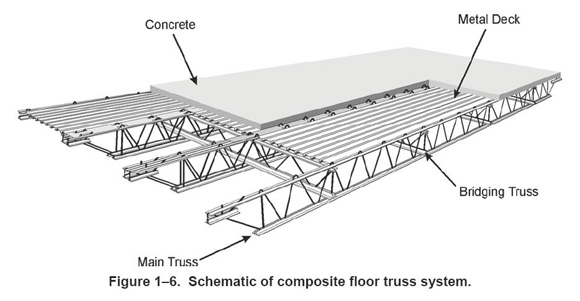
This is the roof structure, or hat truss of the towers...
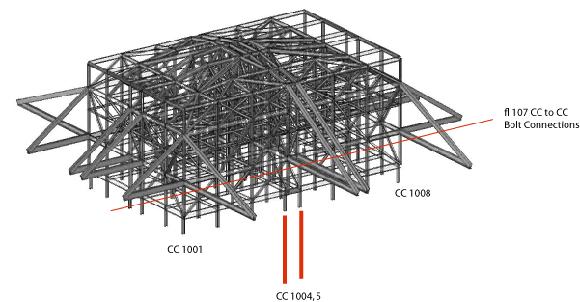
reply to post by Rubicant13
I need to post a warning here about what happened to my computer when I tried to see the “Death Ray” episode online.
I had missed it because my cable tv box died Tuesday & it wasn’t replaced until yesterday (Saturday, Nov 17).
I went to the TruTv site:
www.trutv.com...
Then under the heading “Full Episodes” I clicked on “Death Ray (42:58)”
www.trutv.com...#!/62601/967131
When I tried to play it, a window popped up saying I could not view it without downloading some program.
When I clicked on that, a McAfee window popped up with a warning of “Do you really want to go there?” I ignored it and went.
During the download process, I got really uncomfortable and aborted the download. I shut the computer down.
When I rebooted, I ran PCmatic and sure enough it detected new malware. I cleaned that and rebooted again.
When I went online, I was taken to “Mystart.incredibar.com” – something I’d never seen before, instead of my homepage.
There’s a lot of info on “Mystart. Incredibar.com” at anti-spyware & anti-virus sites hawking their “cleanse” ware.
It’s not really a virus, it’s a “foistware taking the form of a gaming toolbar. As spyware, it tracks your surfing habits and reports what it finds to its maker, who sells that info.
It hijacks your start page & preferred search engine.”
I tried to get rid of it the usual way (searching & uninstalling). No go.
I ended up doing a System Restore to bypass it.. What a p*$$#r.
I need to post a warning here about what happened to my computer when I tried to see the “Death Ray” episode online.
I had missed it because my cable tv box died Tuesday & it wasn’t replaced until yesterday (Saturday, Nov 17).
I went to the TruTv site:
www.trutv.com...
Then under the heading “Full Episodes” I clicked on “Death Ray (42:58)”
www.trutv.com...#!/62601/967131
When I tried to play it, a window popped up saying I could not view it without downloading some program.
When I clicked on that, a McAfee window popped up with a warning of “Do you really want to go there?” I ignored it and went.
During the download process, I got really uncomfortable and aborted the download. I shut the computer down.
When I rebooted, I ran PCmatic and sure enough it detected new malware. I cleaned that and rebooted again.
When I went online, I was taken to “Mystart.incredibar.com” – something I’d never seen before, instead of my homepage.
There’s a lot of info on “Mystart. Incredibar.com” at anti-spyware & anti-virus sites hawking their “cleanse” ware.
It’s not really a virus, it’s a “foistware taking the form of a gaming toolbar. As spyware, it tracks your surfing habits and reports what it finds to its maker, who sells that info.
It hijacks your start page & preferred search engine.”
I tried to get rid of it the usual way (searching & uninstalling). No go.
I ended up doing a System Restore to bypass it.. What a p*$$#r.
reply to post by Drunkenparrot
I thought it showed the construction of the core columns fairly well, as distinguished from the trusses. I could be mistaken. Still, an understanding of the construction doesn't reveal how the entire building exploded from the top down, without any loss or change in momentum, all the way to the ground to within a mere few seconds of absolute freefall in nothing but air.
I thought it showed the construction of the core columns fairly well, as distinguished from the trusses. I could be mistaken. Still, an understanding of the construction doesn't reveal how the entire building exploded from the top down, without any loss or change in momentum, all the way to the ground to within a mere few seconds of absolute freefall in nothing but air.
Originally posted by Drunkenparrot
Originally posted by Rubicant13
Well. I must say that I cannot argue the point that they used A36 regular grade steel. But, this is used in the trusses. Or building roof supports. Trusses are not used in any other floor of a skyscraper other than the roof, or more in detail, the weight support for the roof. What was the grade of steel chosen as the supports for all the other floors?edit on 18-11-2012 by Rubicant13 because: (no reason given)
What we have been discussing is the floor support system.
The term "truss" actually has a much broader meaning than the pitched assembly of chords and webbing that carries the weight of a roof.
If you don't mind using Wikipedia for a source...
There are two basic types of truss:
The pitched truss, or common truss, is characterized by its triangular shape. It is most often used for roof construction. Some common trusses are named according to their web configuration. The chord size and web configuration are determined by span, load and spacing.
The parallel chord truss, or flat truss, gets its name from its parallel top and bottom chords. It is often used for floor construction.
Truss
This is a typical floor section from WTC from the NIST report...
This is the roof structure, or hat truss of the towers...
Ok... I get what you are saying. In my neck of the woods, we do not make flooring sub-levels for buildings in this manner. They are usually made of wood or steel I-beams - both being reinforced by cross patterning supports just as your diagram shows, but we do not call these reinforced floor supports "trusses". I am still curious, were all floors made of the same grade of steel as the hat truss? If so, this was a recipe for disaster from the beginning. I can't fathom why any building contractor would use regular grade mild A36 steel for each floors sub level support make up. I can understand the hat truss though - it holds the least weight and if a fire occurs beneath it, it would not cause colossal damage from the weight of the actual roof itself falling.
reply to post by Rubicant13
I found this episode very interesting. I don't really like the fact that Oliver Stones' son is on the team nor Jesse's son. They rub me the wrong way for some reason. Ok let's move on.
I've always liked John Hutchison. That guy is phenomenal. I would love to see his experiments in person. I would pay quite a bit to see that.
Now, there a couple of thing I'd like to talk about in this episode. The girl that quit because she was too scared. Is there any way that this can be verified, that she didn't just quit because it just wasn't her cup of tea.
Why wouldn't Dr Tom Bearden want to give them an interview after all, he's given many interviews in the past. What he did wasn't a big secret. Seems staged to me.
As for Dr. Fred Bell's wife, does anybody else find her body language to be all wrong for a grieving wife?
Sorry for my skepticism but after the reptilian episode I lost a bit of respect for Ventura. He wasn't objective at all. He seemed like he had an ax to grind. Maybe Alex Jones didn't like Icke taking away some of his listeners. Who knows.
I found this episode very interesting. I don't really like the fact that Oliver Stones' son is on the team nor Jesse's son. They rub me the wrong way for some reason. Ok let's move on.
I've always liked John Hutchison. That guy is phenomenal. I would love to see his experiments in person. I would pay quite a bit to see that.
Now, there a couple of thing I'd like to talk about in this episode. The girl that quit because she was too scared. Is there any way that this can be verified, that she didn't just quit because it just wasn't her cup of tea.
Why wouldn't Dr Tom Bearden want to give them an interview after all, he's given many interviews in the past. What he did wasn't a big secret. Seems staged to me.
As for Dr. Fred Bell's wife, does anybody else find her body language to be all wrong for a grieving wife?
Sorry for my skepticism but after the reptilian episode I lost a bit of respect for Ventura. He wasn't objective at all. He seemed like he had an ax to grind. Maybe Alex Jones didn't like Icke taking away some of his listeners. Who knows.
Originally posted by NewAgeMan
As to the twin towers - because they came down in a manner indicating precise timing, and, because of the actual presence of active thermitic material in the dust, I think it's safe to say that an explosive, rather than a DEW phenomenon, was involved.
No, actually, I think it's safe to say you've been suckered by the con atists behind those damned fool conspiracy web sites. It's pretty much proven by now that the "thermitic material" report is rubbish and it's been determined it's some form of paint...
James Millette's WTC dust study
...which isn't surprising, seeing that Steven Jones always insisted there was a conspiracy *before* he ever even started doing his research into the dust. Heck, the guy isn't even a chemist.
new topics
-
President BIDEN's FBI Raided Donald Trump's Florida Home for OBAMA-NORTH KOREA Documents.
Political Conspiracies: 4 hours ago -
Maestro Benedetto
Literature: 5 hours ago -
Is AI Better Than the Hollywood Elite?
Movies: 6 hours ago -
Las Vegas UFO Spotting Teen Traumatized by Demon Creature in Backyard
Aliens and UFOs: 9 hours ago -
2024 Pigeon Forge Rod Run - On the Strip (Video made for you)
Automotive Discussion: 10 hours ago -
Gaza Terrorists Attack US Humanitarian Pier During Construction
Middle East Issues: 10 hours ago -
The functionality of boldening and italics is clunky and no post char limit warning?
ATS Freshman's Forum: 11 hours ago
top topics
-
President BIDEN's FBI Raided Donald Trump's Florida Home for OBAMA-NORTH KOREA Documents.
Political Conspiracies: 4 hours ago, 26 flags -
Krystalnacht on today's most elite Universities?
Social Issues and Civil Unrest: 15 hours ago, 9 flags -
Supreme Court Oral Arguments 4.25.2024 - Are PRESIDENTS IMMUNE From Later Being Prosecuted.
Above Politics: 15 hours ago, 8 flags -
Weinstein's conviction overturned
Mainstream News: 14 hours ago, 8 flags -
Massachusetts Drag Queen Leads Young Kids in Free Palestine Chant
Social Issues and Civil Unrest: 12 hours ago, 7 flags -
Gaza Terrorists Attack US Humanitarian Pier During Construction
Middle East Issues: 10 hours ago, 7 flags -
Las Vegas UFO Spotting Teen Traumatized by Demon Creature in Backyard
Aliens and UFOs: 9 hours ago, 6 flags -
Meadows, Giuliani Among 11 Indicted in Arizona in Latest 2020 Election Subversion Case
Mainstream News: 12 hours ago, 5 flags -
2024 Pigeon Forge Rod Run - On the Strip (Video made for you)
Automotive Discussion: 10 hours ago, 4 flags -
Is AI Better Than the Hollywood Elite?
Movies: 6 hours ago, 3 flags
active topics
-
Gaza Terrorists Attack US Humanitarian Pier During Construction
Middle East Issues • 28 • : firerescue -
Supreme Court Oral Arguments 4.25.2024 - Are PRESIDENTS IMMUNE From Later Being Prosecuted.
Above Politics • 89 • : WeMustCare -
SHORT STORY WRITERS CONTEST -- April 2024 -- TIME -- TIME2024
Short Stories • 23 • : DontTreadOnMe -
President BIDEN's FBI Raided Donald Trump's Florida Home for OBAMA-NORTH KOREA Documents.
Political Conspiracies • 16 • : Astyanax -
Truth Social goes public, be careful not to lose your money
Mainstream News • 130 • : Astyanax -
Las Vegas UFO Spotting Teen Traumatized by Demon Creature in Backyard
Aliens and UFOs • 11 • : AwakeNotWoke -
Is AI Better Than the Hollywood Elite?
Movies • 13 • : Justoneman -
Hate makes for strange bedfellows
US Political Madness • 47 • : 19Bones79 -
-@TH3WH17ERABB17- -Q- ---TIME TO SHOW THE WORLD--- -Part- --44--
Dissecting Disinformation • 689 • : daskakik -
University of Texas Instantly Shuts Down Anti Israel Protests
Education and Media • 265 • : Astrocometus
